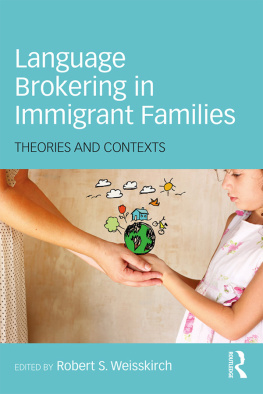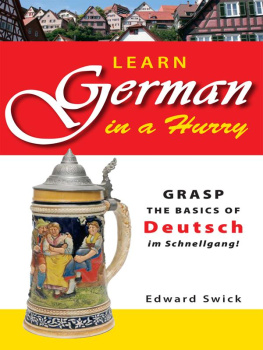GENERAL OVERVIEWS
The last person to attempt this daunting task of synthesis was a professor of German who published mostly in history, LaVern J. Rippley, The German-Americans (Boston: Twayne Publishers, 1976). A helpful template was furnished by Kathleen Neils Conzen, Germans, in Harvard Encyclopedia of American Ethnic Groups, eds. Stephan Thernstrom, Ann Orlov, and Oscar Handlin (Cambridge, MA: Harvard University Press, 1980). My monograph, The Westfalians: From Germany to Missouri (Princeton, NJ: Princeton University Press, 1987), although a transatlantic regional study, includes many side glances at other regions of Germany and the United States. Many of the immigrant letters cited here were published in Walter D. Kamphoefner, Wolfgang Helbich, and Ulrike Sommer, eds., News From the Land of Freedom: German Immigrants Write Home (Ithaca, NY: Cornell University Press, 1991). A number of chapters in the anthology edited by Wolfgang Helbich and Walter D. Kamphoefner, German-American Immigration and Ethnicity in Comparative Perspective (Madison, WI: Max Kade Institute, 2004), were drawn upon in various chapters. Two eyewitness memoirs quoted frequently in this work were coedited with colleagues of mine: Gert Goebel, Longer than a Mans Lifetime in Missouri, ed., with Adolf E. Schroeder, (Columbia: State Historical Society of Missouri, [1877] 2013); and Preserving German Texan Identity: Reminiscences of William A. Trenckmann, 18591935, ed., with Walter L. Buenger (College Station: Texas A&M University Press, 2019). Also referenced in multiple chapters are Adolf E. Schroeder, ed. and trans., Hold Dear, as Always: Jette, A German Immigrant Life in Letters (Columbia: University of Missouri Press, 1988); and Hans L. Trefousse, Carl Schurz, a Biography (Knoxville: University of Tennessee Press, 1982). The cartoons cited here were reprinted in Thomas Nast St. Hill, Thomas Nast: Cartoons and Illustrations (New York: Dover Pulications, Inc., 1974). Many of the newspaper citations here were derived from two online databases with full-text search capacity: the WPA translations in the Chicago Foreign Language Press Survey digitized by the Newberry Library, https://flps.newberry.org/; and the Texas Digital Newspaper Collection, which is part of the Portal to Texas History created at the University of North Texas: https://texashistory.unt.edu/explore/collections/TDNP/.
An important resource, not only for manuscript census information on the ancestry and generation of individuals, but also (besides published census returns) for many of the city and county population figures cited here, is Ancestry.com. It is a well-kept secret that searches on Ancestry do not require a name, but can be conducted for exact matches of other characteristicsfor example, American-born persons with one Irish and one German parent nationwide. Searches can be further restricted to a specific geographic areafor example, female domestics living in St. Louis who were born in Illinois with a German father.
CHAPTER 1: BEFORE THE GREAT FLOOD: GERMANS IN COLONIAL AND REVOLUTIONARY AMERICA
This chapter relies heavily on Aaron Fogelman, Hopeful Journeys: German Immigration, Settlement, and Political Culture in Colonial America, 17171775 (Philadelphia: University of Pennsylvania Press, 1996), and the parallel work of Marcus Hberlein, The Practice of Pluralism: Congregational Life and Religious Diversity in Lancaster, Pennsylvania, 17301820 (University Park: Pennsylvania State University Press, 2009). On the beginnings, see Stephanie Grauman Wolf, Urban Village: Population, Community, and Family Structure in Germantown, Pennsylvania, 16831800 (Princeton, NJ: Princeton University Press, 1977). On the language issue, see Hermann Wellenreuther, Citizens in a Strange Land: A Study of German-American Broadsides and their Meanings for Germans in North America, 17301830 (University Park: Pennsylvania State University Press, 2015); and Friederike Baer, The Trial of Frederick Eberle: Language, Patriotism, and Citizenship in Philadelphias German Community, 1790 to 1830 (New York: New York University Press, 2008).
CHAPTER 2: SOURCES AND CAUSES OF NINETEENTH-CENTURY EMIGRATION
Two important works on the German background are Mack Walker, Germany and the Emigration, 18161885 (Cambridge, MA: Harvard University Press, 1964); and Wolfgang Kllmann and Peter Marschalck, German Emigration to the United States, Perspectives in American History 7 (1973): 499554. More recent work includes my chapter, German Migration Research, North, South, and East: Findings, Methods, and Open Questions and two other chapters drawn from published dissertations available only in German: Axel Lubinski, Overseas Emigration from Mecklenburg-Strelitz: The Geographic and Social Contexts; and Uwe Reich, Emigration from Regierungsbezirk Frankfurt/Oder, 18151893, all in Dirk Hoerder and Jrg Nagler, eds., People in Transit: German Migrations in Comparative Perspective (Cambridge, MA: Cambridge University Press, 1995): 1933, 5778, 79100. For an analysis of migration selectivity, see Timothy G. Anderson, On the Pre-Migration Social and Economic Experience of Nineteenth-Century German Immigrants, Yearbook of German-American Studies 36 (2001): 91108. On the effects of inheritance patterns, see Simone A. Wegge, To Part or Not to Part: Emigration and Inheritance Institutions in Nineteenth-Century Hesse-Cassel, Explorations in Economic History 36 (1999): 3055. For the latest on shipping, see Raymond L. Cohn and Simone A. Wegge, Overseas Passenger Fares and Emigration from Germany in the Mid-Nineteenth Century, Social Science History 41 (2017): 393413; and Raymond L. Cohn, Mass Migration under Sail: European Immigration to the Antebellum United States (New York: Cambridge University Press, 2009).
CHAPTER 3: GERMAN SETTLEMENT PATTERNS IN NINETEENTH-CENTURY AMERICA
This chapter leans heavily on my article, Immigrant Epistolary and Epistemology: On the Motivators and Mentality of Nineteenth-Century German Immigrants, Journal of American Ethnic History 28 (2009): 3454; supplemented by Uprooted or Transplanted? Reflections on Patterns of German Immigration to Missouri, Missouri Historical Review 103 (2009): 7189. It also draws upon my chapter, Paths of Urbanization: St. Louis in 1860, and others in the anthology by Eberhard Reich-mann, LaVern J. Rippley, and Jrg Nagler, eds., Emigration and Settlement Patterns of German Communities in North America (Indianapolis, IN: Max Kade German-American Center, 1995): 25872. For contrasting views on the chain migration paradigm, see Robert W. Frizzell, Migration Chains to Illinois: The Evidence from German-American Church Records, Journal of American Ethnic History 7 (1987): 5973; and Jochen Krebber, Creed, Class, and Skills: Three Structural Limitations of Chain Migration, in European Mobility: Internal, International, and Transatlantic Moves in the 19th and Early 20th Centuries, eds. Annemarie Steidl, Josef Ehmer, et al., (Gttingen, Germany: V&R Unipress, 2009): 6977, presenting results from a larger work available only in German. For a quantitative analysis of other immigrant destinations, see my article, Who Went South? The German Ethnic Niche in the Northern and Southern Hemispheres, Social Science History 41 (2017): 36392. Three of the best urban case studies are Kathleen Neils Conzen, Immigrant Milwaukee, 18361860: Accommodation and Community in a Frontier City (Cambridge, MA: Harvard University Press, 1976); Stanley Nadel, Little Germany: Ethnicity, Religion, and Class in New York City, 18451880 (Chicago: University of Illinois Press, 1990); David A. Gerber, The Making of an American Pluralism: Buffalo, New York, 18251860










